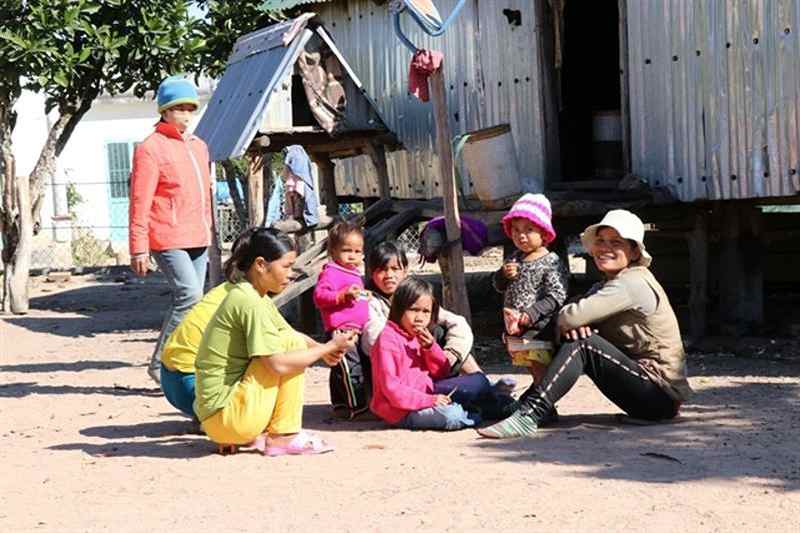
Women and girls in Gia Lai Province
18:40 JST, December 19, 2021
The results from Vietnam’s largest ever survey have painted a clearer picture of the lives of children and women in the country, touching on issues such as maternal health, education, equality and domestic violence.
The survey on the Sustainable Development Goal indicators for children and women in the period of 2020-2021, the largest of its kind in both Vietnam and in the world so far, will provide a scientific basis for policymakers and researchers to make changes to improve the rights and wellbeing of children and women in Vietnam, experts have said.
The comments were made after the survey was released on Dec. 8 in Hanoi by the General Statistics Office (GSO), the United Nations Children’s Fund (UNICEF) of Vietnam and the United Nations Population Fund (UNFPA).
UNICEF Representative in Vietnam Rana Flowers emphasized that the survey’s data is incredibly rich and extremely useful to understand where development approaches are progressing well and where disparities exist, to ensure that no one is left behind.
“The value of this report lies in how we now take these findings and adjust the policies and approaches to better reach the children and women at risk of being left behind. The survey results give us up to date information that factors in some of the early COVID-19 challenges that families have experienced, the burden that women bear and the risks to their lifelong development that children face, including those living in ethnic populations such as Mong or Khmer, those residing in remote and mountainous regions or those living with disabilities,” she said.
According to her, there are five highlights of the survey results.
Firstly, ethnic minority women and children, especially Mong, are the most vulnerable group in terms of the United Nations’ sustainable development targets. There is still inequality in access to living conditions, sanitation, and education.
Figures from the survey show only 36.1% of Mong women are literate while the rate in other minority women is 69.4%. Up to 5.4% of Mong households don’t have access to electricity and clean energy for cooking — the lowest rate among five ethnic groups.
Ethnic minority girls face many risks, such as child marriage and difficulty in getting to school. Mong adolescent girls with no education and belonging to the poorest households are more likely to give birth than their peers in other groups.
Secondly, the survey demonstrated the lack of access to the internet, especially the lack of information technology skills of people across the country. Although more than 80% of people aged 15-49 have access to the internet, only over 30% know how to use computers.
Thirdly, the data show that the risk of children dropping out of school increases gradually by grade level and age group. At the primary level, 98.2% of children go to school at the right age and only 1.2% of children do not attend school, but the rate decreased to 78.1% and up to 21.6% drop out of school at the upper secondary level. The school completion rate also tends to decrease; 86.8% instead of 98.3% at the primary level and 86.8% instead of 98.3% at the lower secondary level.
From these figures, it can be seen that in the context of economic difficulties, many children have to drop out of school and go to work very early, she said.
Fourthly, child discipline using domestic violence is still a common practice in the country. This is a big concern because it will cause long-term consequences for a child’s life, affecting mental health and well-being, leading to a higher risk of child abuse or psychoactive substance abuse.
Finally, the results find that up to 50% of Vietnamese people nationwide are using and drinking water that does not meet water quality standards. Of that, 41.1% are drinking water contaminated with E. coli.
“This is an area that requires us to act urgently and we will need regular monitoring,” she said.
This is the largest multiple indicator cluster survey in Vietnam with the participation of more than 14,000 households across 700 locations in all 63 cities and provinces nationwide. The survey was carried out between November 2020 and February 2021. The households are representative of five ethnic minorities in six economic regions and the two major cities of Hanoi and Ho Chi Minh City.
"World" POPULAR ARTICLE
-

8 Japanese Nationals Stranded on Indonesia’s Sumatra Island
-

U.S. Senate Resolution Backs Japan, Condemns China’s Pressure
-

Mozambican Cooking Class Held in Matsuyama, Ehime Pref.; Participants Don Aprons, Bandanas Made from Traditional Mozambique Fabric
-

China to Impose Sanctions on Shigeru Iwasaki, Former Head of Japan’s Self-Defense Forces, Who Serves as Adviser to Taiwan’s Executive Branch
-

South Korea’s Top Court Dismisses Nippon Steel Appeal in Lawsuit over Requisitioned Worker
JN ACCESS RANKING
-

Tokyo Economic Security Forum to Hold Inaugural Meeting Amid Tense Global Environment
-

Keidanren Chairman Yoshinobu Tsutsui Visits Kashiwazaki-Kariwa Nuclear Power Plant; Inspects New Emergency Safety System
-

Imports of Rare Earths from China Facing Delays, May Be Caused by Deterioration of Japan-China Relations
-

University of Tokyo Professor Discusses Japanese Economic Security in Interview Ahead of Forum
-

Japan Pulls out of Vietnam Nuclear Project, Complicating Hanoi’s Power Plans






















